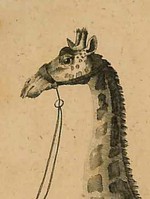Natural history for children
|
Naturgeschichte für Kinder, von M. Georg Christian Raff, ordentlichen Lehrer der Geschichte und Geographie auf dem Lyceum zu Göttingen. Mit fünfzehn Kupfertafeln, worunter die Abbildung der Giraffe, welche sich in der k. k. Menagerie in Schönbrunn befindet. Dreyzehnte verbesserte und vermehrte Auflage. - Wien : Bey Anton v. Haykul und bey Mich[ael] Lechner, 1829. Austrian National Library, shelfmark: 310.254-B.Alt-Mag Georg Christian Raff (1748-1788) belonged to a new generation of teachers and authors who attempted to present knowledge in a manner suitable for children. In his Naturgeschichte für Kinder (Natural History for Children) he aimed at a style meant to appeal to his young readers, but earning him sharp criticism as well. „His Geography, Natural History and History have contributed much, very much to the spreading of useful knowledge, and that is why we bless his ashes. But we have to admit that his style did not please us at all, being nauseatingly childish … How different it is when Campe or Salzmann are speaking to the children!“, runs the verdict of the Handbuch Charakteristik der Erziehungsschriftsteller Deutschlands (Manual of Educational Authors of Germany), published shortly after Raff’s untimely death. While unable to stand up to those masters of juvenile literature, Raffs Natural History turned out to be quite popular. It was translated into several languages and went through many editions well into the 19th century. The first of several Viennese editions was published by Trattner in 1791. Our newly acquired copy of a 1829 edition by Anton von Haykul contains 15 pretty copperplate illustrations, one of them distinctly „local“: In the summer of 1828, the imperial menagerie at Schönbrunn received its first giraffe, a present of the viceroy of Egypt to the emperor. The poor animal died in the following spring, having enjoyed immense popularity with the public during its short life. The giraffe in the picture (left) can be easily identified as the Viennese specimen by the unnatural position of ist legs. The young bull had to travel all the way from its native Darfur to Cairo strapped to the back of a camel. This treatment very likely caused the fracture of the neck of both femurs, indirectly leading to the animals death and diagnosed only at the autopsy. (Klick on image teasers to view full image.)
|


